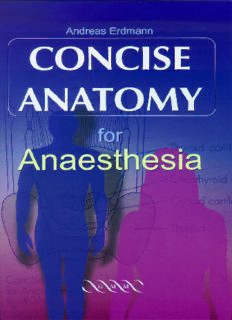
Concise anatomy for anaesthesia PDF
Preview Concise anatomy for anaesthesia
Concise Anatomy for Anaesthesia This page intentionally left blank Concise Anatomy for Anaesthesia Andreas G Erdmann Fellow in Pain Management London Specialist Registrar in Anaesthesia East Anglian Deanery London San Francisco Greenwich Medical Media 4th Floor, 137 Euston Road, London NW1 2AA 870 Market Street, Ste 720 San Francisco CA 94109, USA ISBN 1841100692 First Published 2001 Apart from any fair dealing for the purposes of research or private study, or criticism or review, as permitted under the UK Copyright Designs and Patents Act 1988, this publication may not be reproduced, stored, or transmitted, in any form or by any means, without the prior permission in writing of the publishers, or in the case of reprographic reproduction only in accordance with the terms of the licences issued by the appropriate Reproduction Rights Organisations outside the UK. Enquiries concerning reproduction outside the terms stated here should be sent to the publishers at the London address printed above. The rights of Andreas Erdmann to be identified as author of this work have been asserted by him in accordance with the Copyright Designs and Patents Act 1988. The publisher makes no representation, express or implied, with regard to the accuracy of the information contained in this book and cannot accept any legal responsibility or liability for any errors or omissions that may be made. A catalogue record for this book is available from the British Library. gm@greenwich-medical.co.uk Distributed worldwide by Plymbridge Distributors Ltd and in the USA by Jamco Distribution Typeset by Phoenix Photosetting, Chatham, Kent Printed by The Alden Group, Oxford Contents Foreword vii Lumbar 54 Preface ix Sacrococcygeal 56 18. The major peripheral nerves 60 Upper limb 60 Lower limb 62 Respiratory System Abdominal wall 66 1. The mouth 2 Intercostal nerves 66 2. The nose 4 19. The autonomic nervous system 70 3. The pharynx 6 Sympathetic 70 4. The larynx 8 Parasympathetic 72 5. The trachea 14 20. The cranial nerves 76 6. The bronchi and bronchial tree 16 7. The pleura and mediastinum 18 Appendices 8. The lungs 20 1. Dermatomes of arm 88 9. The diaphragm 22 2. Dermatomes of leg 89 Sample questions 24 3. Dermatomes of trunk 90 Sample questions 91 Cardiovascular System 10. The heart 26 Vertebral Column 11. The great vessels 30 21. The vertebrae 94 Aorta 30 22. The vertebral ligaments 100 Great arteries of the neck 30 Sample questions 101 Arteries of the limbs 32 Major veins 34 Areas of Special Interest 12. Fetal circulation 38 23. The base of the skull 104 Sample questions 40 24. The thoracic inlet 108 25. The intercostal space 112 26. The abdominal wall 114 Nervous System 27. The inguinal region 116 13. The brain 42 28. The antecubital fossa 118 14. The spinal cord 44 29. The large veins of the neck 120 15. The spinal meninges and 30. The axilla 122 spaces 47 31. The eye and orbit 124 16. The spinal nerves 50 Sample questions 128 17. The nervous plexuses 52 Cervical 52 Brachial 52 Index 137 v This page intentionally left blank Foreword When I first started my anaesthesia job, it modern anaesthetic practice. It will be did not take me long to realise that I was invaluable as a revision text for the going to have to relearn a lot of anatomy FRCA, but will also help anaesthetists to that had been implanted in my short- retain anatomy knowledge throughout term memory during the second MB. I their careers. It will be useful for was, incorrectly, under the impression consultants teaching trainees and also for that anatomy was the sole preserve of the other theatre personnel to understand the surgeon. procedures carried out by anaesthetists. From the moment that a career in I am sure that generations of anaesthetists anaesthesia is started, anatomy plays a will be grateful to Dr Erdmann for part. Dr Andreas Erdmann decided to providing such a simple and write this book following his experiences comprehensive review of an essential during the final FRCA examination. The subject. idea is a simple one, combining simple line diagrams and succinct text to cover Richard Griffiths MD FRCA all of the areas of anatomy essential to Peterborough, June 2001 vii This page intentionally left blank Preface The origin of this concise book of constraints of this book to provide in- anatomy results from many comments depth detail and this should be obtained from FRCA examination candidates. by reference to some of the larger Anatomy has always played an important textbooks. Sample questions are included role in the examination syllabus, as well at the end of each section, and include as being of great practical importance in questions similar to those asked in the everyday practice of anaesthesia. It is previous examinations. also a subject that appears to demand a disproportionately large amount of time It is hoped that this book may also be of during examination preparation. help to those teaching anatomy to However, neglect of the anatomical FRCA candidates, as well as to all subject-matter is perilous and leads to the practising anaesthetists wishing to ‘brush loss of valuable ‘easy’ marks. up’ on some forgotten anatomical detail. Nurses, operating theatre practitioners The idea behind this book is to present a and other healthcare professionals will concise and easily digestible outline of also find this book of use when gaining a anatomy that has been extensively based practical understanding of applied on the current FRCA examination anatomy. syllabus. I have attempted to present the core anatomical knowledge required for Finally, all errors and omissions are my the Primary and Final FRCA responsibility, and any comments and examinations in a simple and advice for improvement will be gratefully straightforward manner. There are accepted. numerous diagrams to illustrate the subject matter, as well as additional space Andreas Erdmann for the addition of personal notes. It is, June 2001 however, impossible within the ix
